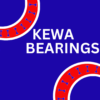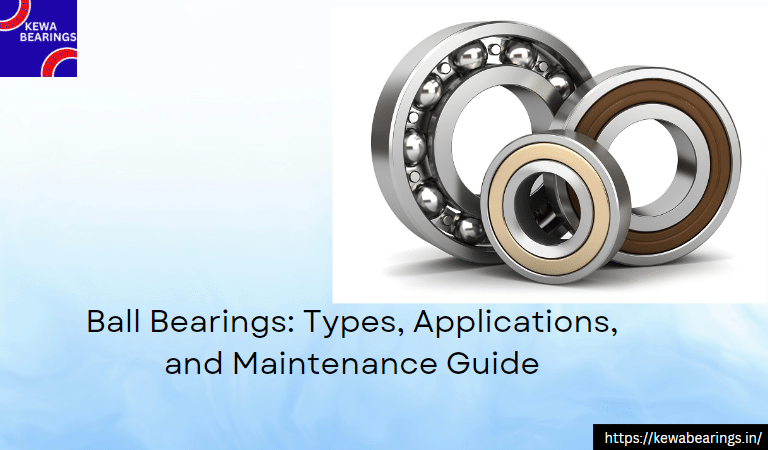Since the very inception of machinery, ball bearings have been the heartthrob of the machinery and construction industry in India. There is no iota of doubt that all bearings are essential components used in various industries and applications to facilitate smooth and efficient rotational motion. These are commonly used in machinery, vehicles, and equipment where low friction and high precision are required. In this guide, Kewa Bearings will be telling you about the different types of ball bearings, their applications, and maintenance tips to ensure their optimal performance and longevity.
Manufacturing and the Materials Used
Ball bearings consist of several key components. The inner ring, outer ring, and balls are the primary ball bearing materials. The inner ring is usually mounted on the rotating shaft, while the outer ring is typically attached to the stationary housing. The balls, typically made of steel or ceramic materials, roll between the inner and outer rings, reducing friction and enabling smooth rotation. The rings and balls of these are commonly made of steel. High-quality bearings often use chrome steel, which offers excellent hardness, durability, and corrosion resistance. In certain applications, such as high-speed or high-temperature environments, ceramic fag bearing balls made of materials like silicon nitride or zirconia may be used for their superior heat resistance and reduced weight.
Seals, Shields, and Other Salient Features
Ball bearing material can be made into seals or shields to protect the internal components from contamination. Seals are made of rubber or synthetic materials and provide a physical barrier against dirt, moisture, and other contaminants. Shields, typically made of metal, offer partial protection by covering only a portion of the bearing, leaving a small gap for lubrication access.
These are manufactured to specific precision levels, which determine their dimensional accuracy and operating characteristics. In some applications, such as machine tool spindles, it is necessary to apply a preloading force to the bearings. Preloading minimizes internal clearances and increases stiffness, resulting in improved precision and reduced vibration during operation.
Types
At Kewa Bearings, we manufacture and supply bearings that can fulfill the needs of a variety of industries. These include:
-
-
Deep Groove Bearings: These bearings have a simple design with deep raceway grooves, allowing them to support both radial and axial loads. They are commonly used in applications such as electric motors, household appliances, and pumps.
-
-
-
Angular Contact Ball Bearings: Designed to withstand combined radial and axial loads, angular contact bearings have contact angles that enable them to support higher thrust loads. They are widely used in automotive applications, machine tools, and gearboxes.
-
-
-
Thrust Ball Bearings: As the name suggests, thrust bearings are designed to handle primarily axial loads. They consist of two grooved washers with all elements in between. They are commonly used in applications like automotive transmissions, steering systems, and industrial machinery.
-
-
-
Self-Aligning Ball Bearings: These bearings have the ability to self-align, accommodating misalignments between the shaft and housing. They are suitable for applications where shaft deflections or misalignments are expected, such as textile machinery and conveyor systems.
-
-
-
Miniature and Instrument Ball Bearings: These bearings are smaller in size and often used in delicate instruments, computer fans, and small electric motors. They are available in various configurations, such as open, shielded, or sealed.
-
In addition to the deep groove bearing and other standard types mentioned earlier, there are specialized bearings designed for specific applications. For example, high-temperature bearings can withstand elevated operating temperatures, while high-speed bearings are designed to handle rotational speeds above standard limits. Other specialized bearings include corrosion-resistant bearings, hybrid bearings (combining steel and ceramic elements), and vacuum-compatible bearings. Given the variety of bearings available, what sort of usage do they have? We will tell you.
Applications
Given the features they come with, these find applications in a wide range of industries and equipment, including:
-
-
Automotive: They are used in engines, transmissions, wheel hubs, and steering systems.
-
-
- Industrial Machinery: Ball bearing material is a crucial component of a variety of machinery, such as pumps, compressors, conveyor systems, and printing machines.
-
-
Aerospace: They are used in aircraft engines, landing gear systems, and control mechanisms.
-
-
- Electric Motors: These support the rotating shafts of electric motors, providing smooth and efficient operation.
-
- Household Appliances: Many household appliances, including washing machines, refrigerators, and air conditioners, rely on ball bearing lubrication for their mechanical components.
With such wide usage, how is one supposed to maintain these? Move to the next section to know more.
Maintenance Guide
Proper maintenance is essential to ensure their longevity and optimal performance. Here are some maintenance tips from our end:
-
- Contamination Control: Keep the ball bearing material clean and free from dirt, dust, and other contaminants. Use seals or shields to protect the bearings from external elements.
-
- Inspection: Regularly inspect the bearings for signs of damage, such as excessive noise, vibration, or heat. Replace any worn-out or damaged bearings promptly.
-
- Lubrication: Regularly lubricate the bearings using the manufacturer-recommended ball bearing lubrication material. Proper lubrication reduces friction, heat, and wear, extending the bearing’s life.
-
- Correct Handling: Handle these with care to prevent impact or dropping, which can cause internal damage. Use proper tools and techniques when installing or removing bearings.
-
- Load Considerations: This one works wonders for groove bearings. Ensure that the bearings are correctly loaded within their specified limits. Excessive loads can lead to premature wear or failure.
-
- Temperature Control: Avoid extreme temperature conditions that can adversely affect the performance of the bearings. Follow the manufacturer’s temperature guidelines.
-
- Regular Maintenance Schedule: Develop a maintenance schedule for your equipment, including bearing inspections, lubrication, and replacement if necessary.
Always remember to consult the manufacturer’s guidelines. By following these guidelines, you can maximize the lifespan of the ball bearing material used, reducing downtime and ensuring smooth operations in various applications.
How to Choose A Bearing?
Choosing the right bearing for a particular application involves considering factors such as load capacity, speed requirements, the requisite ball bearing lubrication, temperature conditions, and environmental factors. Manufacturers provide catalogs and technical specifications that help in selecting the appropriate bearing type and size based on these factors.
What To Do When the Bearing Fails?
Bearing Failure Analysis: In the event of a bearing failure, it is important to analyze the cause to prevent a recurrence. Common causes of bearing failure include improper ball bearing lubrication material, contamination, overloading, misalignment, inadequate handling, and insufficient maintenance. Identifying the root cause helps in implementing corrective measures and selecting the right replacement bearings.
The Bottom Line
These bearings are widely used across industries due to their efficiency, reliability, and versatility. Understanding their types, applications, and maintenance requirements including the ball bearing lubrication allows for effective usage and ensures the smooth operation of machinery and equipment. Remember that specific applications and industries may have unique requirements and considerations for them. Consulting with bearing manufacturers, engineers, or industry experts can provide more detailed information tailored to your specific needs.
Get a decent quote now from us at https://kewabearings.in/ball-bearings/.


Pingback: Ball Bearing Material: Impact on Noise and Vibration - KEWA BEARINGS